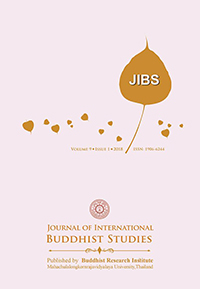Digital Age Buddha Sàsana: Reality Check on the Status Quo during Covid19 Pandemic
Keywords:
Buddha Sàsana, Digital Age, International SurveyAbstract
Buddha Sàsana refers to the Buddha’s Dispensation which comprise of the teachings of the Buddha, doctrine, discipline and practices (including spiritual traditions of Theravāda and Mahāyāna / Vajrayāna schools), as well as associated dissemination. As a spiritual and profoundly philosophical approach to guide effective ways out of suffering, the essence of Buddhism can be distilled as the Four Noble Truths. While seismic changes take shape withthe global transition from Information/Knowledge Age to Digital Age, most aspects of conditions for humanity have dramatically changed.Particularly in the past two years, the global Covid19 pandemic has further exacerbated suffering while fueling digital transformation. How has the Buddha Sàsana been impacted? A pioneering international survey was undertaken to gain reality check glimpses of lived experiences, and attempts to harvest prevailing perceptions from three significant dimensions of critical importance to our Buddha Sàsana. Firstly, how optimistic do practising members of the Theravāda and Mahāyāna / Vajrayāna Buddhist Traditions feel about the Buddha’s Dispensation and uncertainties of their living environment as the Buddha Sàsana undergoes ‘aniccà’ and ‘anattà’ phenomena of these challenging times? In order to appraise this, perceptions of living or receiving the 38 blessings as described in Maha Mangala Sutta (PTS: SN 258-269) are used as relevant assessment gauge in Section I of the survey. Secondly, Section II of this survey evaluate the strength of devotees’ faith in the continual efficacy of Dhamma wisdom to effectively resolve vulnerabilities of dukkha arising from complexities of current global challenges. Section III initiates a review of the type and level of customisation needed (if any) in Digital Age Buddhist Education and Training in preparing next generation Buddha Sàsana to transcend arising ambiguities on the path of wisdom development. This timely research article captures the expansive research results in clear, concise and visually self-explanatory infographics.
References
Babbie, Earl. The Practice of Social Research. CA, USA: Wadsworth, Cengage Learning, 2010.
Fielding, Jane and Nigel Gilbert. Understanding Social Statistics. London: Sage Publications Ltd., 2000.
Seneviratne, Kalinga. Empower from Within: Path to Protect Buddhism in Asia. Sydney: Lotus Communication Network, 2021.
Soni, Maha Mangala Sutta: Life’s Highest Blessings. Kandy: BPS Pariyatti Editions, 2020.
Nànàdicca, MahàThera. The 38 Blessings: with the Pàli Text, Translations, Notes, Word for Word Meaning. Singapore: Burmese Buddhist Temple, 1955.
Walliman, Nicholas. Your Research Project: A Step-By-Step Guide for the First-Time Researcher, 2nd edition. London: Sage Publications Ltd., 2005.







